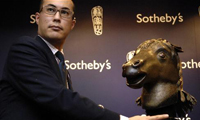 China Urges Return of Saint Laurent Sale Bronzes
China Urges Return of Saint Laurent Sale Bronzes (Update1)
By Eugene Tang and Dune Lawrence
Feb. 12 (Bloomberg) -- China’s government today urged the estate of the late French designer Yves Saint Laurent to return two Qing Dynasty bronze sculptures scheduled for a Feb. 25 auction by Christie’s International in Paris.
The two animal-heads -- a rabbit and a rat -- were severed from a water fountain at Beijing’s imperial Summer Palace when British and French troops plundered and burned the palace in October 1860. They’re now among 700 pieces of art, glassware and sculptures in the Yves Saint Laurent and Pierre Berge Collection that may fetch as much as 300 million euros ($385 million) at auction, according to the London-based auctioneer.
“These relics were stolen, robbed and taken away by invaders in the 20th century,” the Chinese foreign ministry spokeswoman Jiang Yu said today at a Beijing news conference, the first time the Chinese government has commented on the sale. “These should be returned to China.”
Christie’s, in an e-mailed response, said given “the public nature of an auction, the return of these works to China is not guaranteed.”
Some Chinese collectors, enriched by a decade of double- digit economic growth and spurred by nationalism, are scouring the world’s art markets for antiques that they consider stolen national treasure. A group of 81 lawyers volunteered last month to help sue Christie’s to stop the sale.
The auction house said last month that “each and every item” in the Berge Collection has a clear legal title. Today’s statement from Christie’s reiterates that, saying the objects, “including the fountainheads, have a clear and extensive history of ownership.” Proceeds from the sale will help set up a foundation for AIDS research.
The Chinese lawyers have yet to file a suit because they couldn’t find a plaintiff for the case.
Needing a Plaintiff
A search is on to contact the Aixin Juelo clan, the Qing Dynasty royal family, to act as plaintiffs in the case, the Chinese state-owned Xinhua News Agency said today, citing Liu Yang, who heads the group of volunteer lawyers.
The 1995 United Nations Unidroit Convention limits claims on stolen cultural artifacts to within 50 years of their theft. The last Manchu emperor Henry Pu Yi was forced to abdicate in 1911 when China became a republic.
The animal heads were among 12 zodiac symbols at the Summer Palace fountain designed by Jesuit priest Giuseppe Castiglione for the court of Qing Emperor Qianlong.
Tiger Head
Sotheby’s in 2000 sold a tiger head from the same fountain for HK$15 million ($1.9 million) in Hong Kong. In 2003, Hong Kong billionaire Stanley Ho bought the boar head in a private sale and donated it to the Poly Art Museum in Beijing, an affiliate of a company that was run by the People’s Liberation Army. In September 2007, Ho paid $8.9 million for the horse head.
The auction “is a violation of international conventions,” Jiang said today, urging collectors and “the relevant companies” to exercise “caution.” She didn’t elaborate.
More than 1 million pieces of top-grade Chinese relics are scattered in more than 200 museums in 47 nations, according to a 2003 article by state-run Xinhua News. Many objects were taken after t
 China Urges Return of Saint Laurent Sale Bronzes (Update1)
China Urges Return of Saint Laurent Sale Bronzes (Update1)